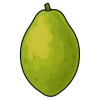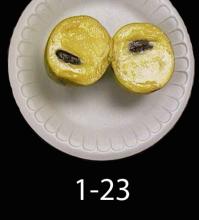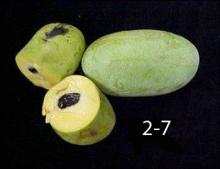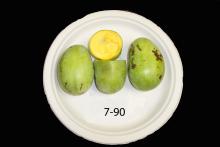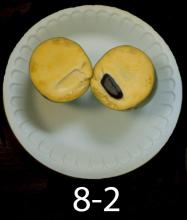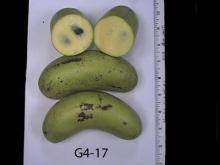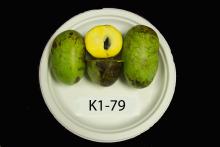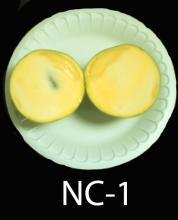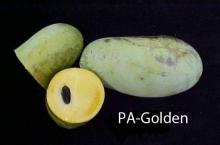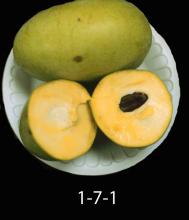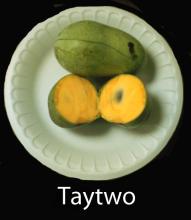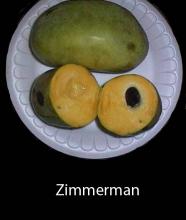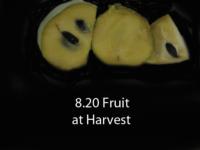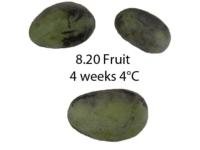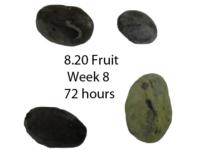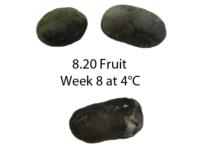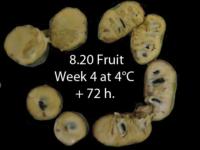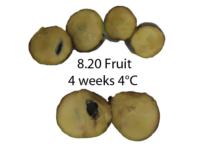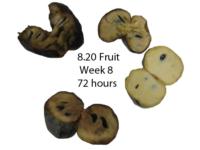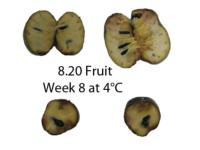Product Description
Indices de Maturité
La seule façon de détecter si la maturation a commencé est d'appuyer doucement ou d’exercer une pression sur le fruit pour déterminer si le ramollissement s’est amorcé. Certains cultivars présentent un changement de couleur de la peau de vert foncé à vert pâle ou même au jaune, et certains présentent aussi un certain brunissement ou assombrissement de la peau à des stades plus avancés de la maturation. La chair peut être de couleur crème, jaune ou orange clair, selon le cultivar, à pleine maturité. La maturation est accompagnée d'une augmentation des composés solubles («degrés Brix»), y compris des sucres (douceur), et d’une production significative d'arômes. Les pawpaws doivent être cueillis lorsque le ramollissement de la chair commence à peine, car ils mûrissent rapidement et deviennent trop mous à manipuler en 3 à 5 jours.
- Une peau verte à vert jaunâtre, des fruits fermes avec coloration brune minimale sur la peau
- Chair tendre et crémeuse
- Chair sucrée (glucose, fructose et saccharose) à > 18-20% de composés solubles
- Un arôme qui rappelle celui de la banane, la mangue, et/ou l’ananas
Sans meurtrissures ni pourrissement
Manipulation et stockage post-récolte
0-4°C (32-40°F) pendant 4 semaines maximum
Des températures basses dans cette gamme et des périodes plus longues de stockage au froid peuvent provoquer des dommages dus au froid.
90-95%
Le taux de respiration à la récolte peut être de 50-100 mg CO2/kg·hr à 20ºC (68°F) et peut augmenter de 2 à 5 fois pour atteindre un pic dans les 3 jours suivant la récolte.
La production d’éthylène à la récolte peut être de 1-4 µg/kg·hr à 20ºC (68°F), et elle peut augmenter jusqu’à 5-15 µg/kg·hr dans les 3 jours suivant la récolte.
Le pawpaw présente une augmentation dans la respiration et la production d’éthylène avec des valeurs maximales dans les 3 jours suivant la récolte indiquant qu’il s’agit d’un fruit climactérique.
Des études en champ et en laboratoire, utilisant des composants chimiques, la modification atmosphérique ou des traitements thermiques qui sont généralement efficaces pour modifier la maturation de nombreux fruits climatériques via un effet sur la biosynthèse ou le mode d’action de l’éthylène, n’ont pas réussi à modifier sensiblement la maturation du pawpaw.
Photos à température et atmosphère contrôlée
Titre : Papaye génotype #8 20 Intact à la récolte. Crédits: Federica Galli, University of Kentucky, Lexington | Titre : Effets de stockage, X-Cut à la récolte. Crédits: Federica Galli, University of Kentucky, Lexington | Titre : Effets de stockage, intacts à 4 semaines + 72 hrs à 4 °C. Crédits: Federica Galli, University of Kentucky, Lexington | Titre : Effets de stockage, intacts à 4 semaines à 4 °C. Crédits: Federica Galli, University of Kentucky, Lexington |
Titre : Effets de stockage, intacts à 8 semaines + 72 heures à 4 °C. Crédits: Federica Galli, University of Kentucky, Lexington | Titre : Effets de stockage, intacts à 8 semaines à 4 °C. Crédits: Federica Galli, University of Kentucky, Lexington | Titre : Effets de stockage, X-Cut à 4 semaines + 72 h 4°C. Crédits: Federica Galli, University of Kentucky, Lexington | Titre : Effets de stockage, X-Cut à 4 semaines 4°C. Crédits: Federica Galli, University of Kentucky, Lexington |
Titre : Effets de stockage, X-Cut à 8 semaines + 72 heures à 4 °C. Crédits: Federica Galli, University of Kentucky, Lexington | Titre : Effets de stockage, X-Cut à 8 semaines 4°C. Crédits: Federica Galli, University of Kentucky, Lexington |
Physiological and Physical Disorders
Dommages dus au Froid. Un brunissement de la peau et de la chair a été observé après 6 semaines de stockage à 0-4°C (32-40°F).
Blessure Physique. Semblable au brunissement des bananes causé par des chocs, les pawpaws peuvent être endommagés au cours de la maturation. Les fruits doivent être manipulés avec précaution pour minimiser les dommages et réduire les pertes après récolte.
Flétrissement. Les symptômes deviennent visibles après 6 semaines de stockage au froid.
Désordres
Des maladies après récolte causées par Cladosporium spp. et Fusarium spp. ont été observées sur les pawpaws après 6 semaines de stockage à 0-4°C (32-40°F).
References
Des références provenant de sources scientifiquement validées seront ajoutées ultérieurement.



